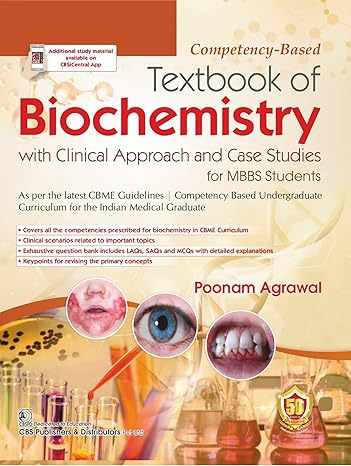Competency Based Textbook Of Biochemistry With Clinical Approach And Case Studies For Mbbs Students (Pb 2023)
Poonam Agrawal MBBS,MD,FIMSA,ACME is currently Professor and Head, Department of Biochemistry, and MEU Coordinator, Dr Baba Saheb Ambedkar Medical College and Hospital, New Delhi. She has been actively involved in teaching biochemistry to medical undergraduate and postgraduate students for the past 17 years. Teaching is her passion and she is popular among her students for simplified and fascinating approach towards the subject with strong clinical connections. Other popular books which she has authored are Concepts in Biochemistry based on CBME; Practical Biochemistry based on CBME and Review of Biochemistry for PGMEE,all brought out by CBSPD. She has completed Advance Course in Medical Education (ACME) conducted by MCI in 2017 and has completed and published many innovative projects in the field of medical education. She is actively involved in research and patient care and her areas of interest are diabetic complication, thyroid dysfunction, novel biomarkers and medical education. She has won a number of awards for her research work presentations at various national and international events. ... Read more Read less
The main emphasis of the latest CBME based curriculum is on developing the clinical correlation of biochemistry in medical student's mind in such a fashion that this complex subject becomes relevant in understanding and approaching the patients afflicted with various metabolic and genetic disorders.
The author's extensive experience of teaching biochemistry to medical students in an easy and focused manner is well reflected in writing the chapters of this textbook. A number of case scenarios are presented in an easy and interesting way and their biochemical basis is explained in a lucid manner. This approach not only makes the subject relevant and easier for student to learn, but also enhances the retention of the subject in the learner's mind.
Highlights
- Covers all the competencies prescribed for biochemistry in CBME curriculum
- Clinical Scenarios related to important topics
- Exhaustive question bank
- Key points for revision
- Additional Study material available on CBSicentral APP which includes Basics of Biochemistry presentation
Features of the book:
- The book is written in a way to make the subject relevant and easier for better retention in learner’s mind
- The book has a Pan –India National Advisory Board
- The book is divided in to 15 sections with 56 chapters each section ends with exhaustive question bank based on the topics covered in respective sections which include:
Long Answers questions (LAQs)
Short Answer questions (SAQs)
Multiple choice questions (MCQs)
Multiple choice questions with answers and detailed explanations
- Each chapter begins with Competency achievement for biochemistry, Specific Learning objectives and ends with key points
- Key Points are given at the end of chapter to revise the primary concepts
- Lots of Clinical case scenarios are given in easy and understanding manner with their biochemical basis which are explained in lucid manner
- A separate chapter on commonly used Laboratory Instruments and equipment are given to upgrade the practical aspect also
- Text highlighted in yellow color provides important information of the topic under focus given as Notes
- At the end of the book MCQs for Revision & Practice are given which includes:
Case based question, Multiple choice questions,Image based questions with their answers and explanations
Around 4 sets of Sample question papers
- Glossary at the end provided to understand the complex terminologies of the subject.











